The Casebooks Project is a team of scholars at the University of Cambridge, led by Professor Lauren Kassell. We spent a decade studying the medical records of the astrologers Simon Forman and Richard Napier. This work produced:
Casebooks digital edition, accessible through this site Casebooks critical introduction, represented by the pages on this site Casebooks manuscripts, accessible through our edition and the Cambridge Digital Library Forman’s guide to astrological medicine Casebooks dataset We use the term ‘Casebooks’ as a shorthand to refer to all of the work of the Casebooks Project. Full references for our outputs are listed on our how to cite us page.
Our work developed as we fathomed the extent of the records and the possibilities of digital tools to capture and display them. From the outset, we released versions of our site and data and welcomed feedback; ultimately this grew into an engagement framework. See releases and events for a chronicle of our many activities. Our work was structured around three phases of funding from the Wellcome Trust. This page sets out the history of Casebooks and acknowledges the people and institutions that made our work possible.
Phase 1: Development and pilot, 2008–9
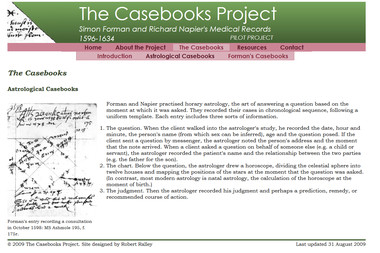
A page from the Casebooks pilot project website.
The work of the Casebooks Project began with a pilot in 2008–9, funded by the Wellcome Trust. Lauren Kassell, Robert Ralley, and Peter Forshaw focused on the six volumes of Simon Forman’s casebooks and produced a database that combined standardised information with excerpts of transcription. The result was saved as a Microsoft Excel file containing slightly over 10,000 rows of data, each corresponding to an entry in the original manuscripts. The database was mounted on a website (www.hps.cam.ac.uk/casebooks) that introduced Forman and his manuscripts. With informal technical guidance from Michael Hawkins, the pilot informed the development of an application for a Wellcome Trust Programme Grant.
Phase 2: Programme Grant, 2010–14
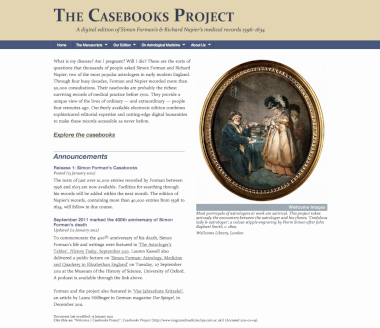
The Casebooks Project website’s homepage in 2011.
With the award of the Programme Grant, Michael Hawkins joined the Casebooks Project as the Technical Director, with Robert Ralley and John Young as Editors in April 2010. We constituted an Advisory Board of Harold Cook, Rob Iliffe, Anthony Grafton, Mark Jenner, Ludmilla Jordanova, Margaret Pelling, Richard Smith, and John Harley Warner. We aimed to produce an ‘electronic edition’ of Forman’s and Napier’s 50,000 cases (an underestimate, as described below), a website, and research publications. The Bodleian Library, University of Oxford, where the original manuscripts are held, agreed to act as a partner to the project and to allow us to include digital scans of the twenty per cent of the casebooks that they held on microfilm.
We planned to work through the volumes chronologically, beginning with Forman’s casebooks. Because Forman had taught Richard Napier his methods, Forman’s casebooks provided the model for the structure of the data. His systematic records of the patient’s name, age, and question meant that we could focus on these details — we call this the ‘question’ — in the full run of cases. We chose not to provide a comprehensive survey of all cases with a view to enabling readers to navigate the corpus as a whole and to identify cohorts of patients and to track individuals, families, and households within it. We were often asked why we did not provide full transcriptions of a sample of cases. Our answer was that we could not select a meaningful sample without knowing what the full corpus contained.
For the full edition, we developed editorial and tagging guidelines based on the Text Encoding Initiative P5 Guidelines using XML (Extensible Markup Language) that permitted a sophisticated combination of transcription and metadata. The transcribed text for each case accounts for only about ten per cent of each file, the rest being the analytical metadata. Our editing practices ensured that each case was transcribed and checked, and then its connections to other cases determined. Linking begins with automated collations showing connections and correspondences between cases and people. These are then manually checked to identify instances in which two people share a single name or where one person has multiple names. Because this process results in changes to the files, we did not release cases until linking was complete. This resulted in lags of several months or more between the completion of transcription and the release of cases.
We launched a new project website in August 2011, and released our first batch of data — Forman’s 10,000 cases — in early 2012. Images, search functions, and person pages followed later that year.
As we began editing Napier’s casebooks, we realised that he did not follow Forman’s system as rigorously as we had anticipated. This complicated the work of the editors and allowed us to provide a more textured view of the casebooks. While the edition focuses on the standard material that comprised the ‘question’ at the beginning of each entry, as we began coding the cases, we often needed to decipher the full entry, including the astrological computations, in order to make sense of the edited text. This applied to basic information, such as the sex of a client. For instance, in a case in which the question reads ‘Adrian Collins of 18 yers 1599 the 24 of Apr’ Tuesday am at 30 post 8 Diz’, we needed to understand the rest of the entry to establish that she was a woman. Reading the full entry also allowed us more precisely to classify the topic of the question and relationships between patients, querents, and third parties involved in the case. Where we found information about circumstances of the consultation, such as a payment, diagnostic information, or prescribed remedy, we also recorded these details.
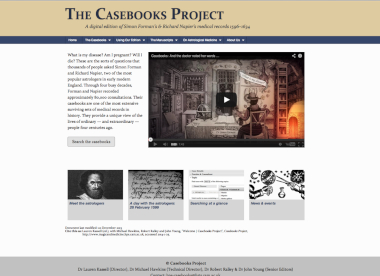
The Casebooks Project website’s homepage in 2014.
We released transcriptions of the first nine volumes of Napier’s casebooks, comprising nearly 12,000 cases from 1597 to 1605 in October 2013. In January 2014, we announced a redesign of the homepage which included a short animated film about the project and additional explanatory material.
Work on Napier’s casebooks revealed a second challenge. We had estimated that his casebooks contained 40,000 consultations. In fact, the number is close to 70,000. Napier’s records are difficult to count because he and his associates increasingly abandoned Forman’s strict format of dividing each page into a grid of two or four cases in favour of more free-form textual entries, often with more cases crammed on a page. To be sure, one of the editors spent several months manually calendaring all of Napier’s volumes, in advance of editing them, to arrive at the correct figure. Together, Forman’s and Napier’s casebooks contain 80,000 consultations.
Given the increased number of cases and the richness of the entries, we reviewed our rate of work and approached the Wellcome Trust about additional funding. We were granted a one-year extension to the Programme Grant and, after an unsuccessful application for an Investigator Award, we were invited to apply for a Strategic Award.
By the end of Phase 2, we had completed work on a third of the cases, including innovative search and visualisation facilities; an image archive of 7,200 pages, based on microfilms of the casebooks; and a website complete with explanatory materials.
Phase 3: Strategic Award, 2014–19
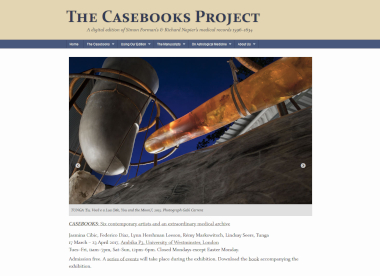
The Casebooks Project website’s homepage in 2017.
With an award of £1 million from the Wellcome Trust, we began our third and final phase of work. We aimed to complete the edition of Napier’s casebooks, establishing a model for the application of digital humanities to historic medical records. At the same time, we reconfigured our work in terms of an engagement framework. This used feedback from academic and public audiences to strengthen our edition. To facilitate this, we reconstituted our Advisory Board to include Gina Czarnecki, Alexandra Franklin, Vanessa Harding, Tim Hitchcock, and Rob Iliffe. Our Senior Editors were joined by a pair of Assistant Editors, Joanne Edge and Yvonne Martin-Portugues. Natalie Kaoukji, a research fellow, worked with Lauren Kassell on implementing the engagement framework. Boyd Brogan, supported by matching funding from the Isaac Newton Trust, began work on a project on chastity diseases, drawing on material from Forman’s and Napier’s casebooks.
To launch this phase of the project, in March 2015 we invited our Advisory Board and two dozen people (listed under acknowledgments) from academic, medical, museum, and other backgrounds to the Weston Library, Oxford. We asked them to reflect on the challenges of this phase of the project, beginning with the questions ‘Is it research?’ and ‘Does it help us to ask new questions or provide new answers to old questions?’ As the report on the workshop summarises, their recommendations were: Maintain a sense of the materiality and defamiliarity of the records, while embracing new media, methods, and questions. Our edition/data should be our priority. Search facilities and the website will follow, but should not dictate the content of the durable output. Do more work to include the astrological chart, judgment, and treatment in the edition. This includes more interpretative work on the astrology. Review our topics, people, and other coded content to ensure that it fully represents the richness of the records and the ritualised processes that created them. Enhance our search facilities, e.g. free text search with intelligent prompts. Make the site less channelled and rigid: encourage users to play. We took these recommendations as prompts to think more openly about how to ensure that these extraordinary documents realized their full digital potential.
In parallel with planning the launch workshop, we designed a programme of engagement events, supported by a Wellcome Provision for Public Engagement, that centred on conversations with six internationally acclaimed artists. Their works were exhibited at Ambika P3, University of Westminster, in spring 2017. Building on the materials we provided for the artists, we produced some selected cases in full, with several hundred cases in modern English and a list of things in the casebooks.
While Casebooks was the driving force in many of our activities, Jennifer Schneidereit of Nyamyam, an independent game developer, turned our model on its head. After she and Lauren Kassell met at a Wellcome Trust event, Jennifer approached us about acting as historical consultants on a game about Simon Forman. Astrologaster is scheduled for release in 2019.
With the Strategic Award, the Wellcome Trust added a budget to pay for colour images of the full run of Forman’s and Napier’s casebooks and the necessary technical support to include them within our edition. This transformed the look and capability of the edition. We released the first batch of colour images in June 2016, and they are now all viewable through our edition and the Cambridge Digital Library. We are grateful to everyone at the Bodleian Library, Oxford and the Cambridge University Library who made this possible.
In February 2016 we released Robert Ralley’s edition of Forman’s massive guide to astrological physic. We continued to improve our website, refine our edition, and release Napier’s cases, with batches in the summers of 2015 and 2016 and a large, final run in 2018.
To complete our work, we were granted a one-year costed extension and a one-year no-cost extension.
Phase 4: Archiving and preservation, 2019–
From the outset, our website ran from a server in the Department of History and Philosophy of Science and our data has been deposited on GitHub. With matching funding from the Isaac Newton Trust and Cambridge’s Wellcome Institutional Strategic Support Fund granted in April 2016, we began work to move to a new site at the Cambridge Digital Library. This is the culmination of all that we have learned. We made a new archive from an old archive. It belongs in a library.
We established the Casebooks Editorial Committee to have oversight and authority over decisions about the future of the project.
Acknowledgments
Everyone named on this page and throughout the site has made Casebooks what it is. We would like especially to thank Simon Chaplin, Lauren Couch, Sue Crossley, Iain Dodgeon, Nils Fietje, Clare Matterson, Dan O’Connor, Liz Shaw, Chloe Sheppard, and Tony Woods at the Wellcome Trust for believing in the project. At the Bodleian Library, University of Oxford, James Allen, Chris Fletcher, Alexandra Franklin, Richard Ovenden, Mike Webb, and their imaging department enabled what no one thought possible. At the Cambridge University Library, Hal Blackburn, Huw Jones, Tuan Pham, Grant Young, and the team at the Digital Content Unit facilitated the move of our site and assured us of its future security. At Ambika P3, Heather Blair, Niall Carter, Katharine Heron, and Michael Mazière made the show happen. Huw Wahl documented it in a beautiful film. Claire Hammon produced the book that accompanied the exhibition, and a long list of credits is included within it. Participants in the Phase 2 launch workshop helped shape the project: they included our Advisory Board plus Silke Ackermann, Leah Astbury, Jonathan Barry, Elma Brenner, Felicity Callard, Lauren Couch, Richard Dunn, Gavin Francis, John Gallagher, Laura Gowing, Mark Jenner, Stephen Johnston, Eric Ketelaar, Philip Kreager, Elaine Leong, Angela McShane, Carla Nappi, Margaret Pelling, Andrew Prescott, Jennifer Richards, Graeme William Tobyn, John Harley Warner, Mike Webb, and Olivia Weisser. Many scholars and students from Cambridge and the rest of the world have asked us questions and encouraged our work. We wish especially to thank Leah Astbury, Pippa Carter, Ofer Hadass, and Elaine Leong for help with terminology and more general feedback too. Katrina Maydom provided invaluable assistance with finalising our Wordpress site. Tamara Hug, Administrator of the Department of History and Philosophy of Science, dealt with everything from the beginning of the project to its end — each grant application, budget, memorandum of understanding, and contract — with immense skill, tact, and efficiency. Our colleagues have come to accept Casebooks as part of the furniture, while still occasionally asking ‘What is the Casebooks Project?’ The Casebooks Project is a team of scholars who spent a decade studying the medical records of a pair of astrologers. As our families and friends know, it is more than a job. We are grateful to them for all their encouragement, help, and patience. Our work is complete, but Casebooks in its many forms continues.

